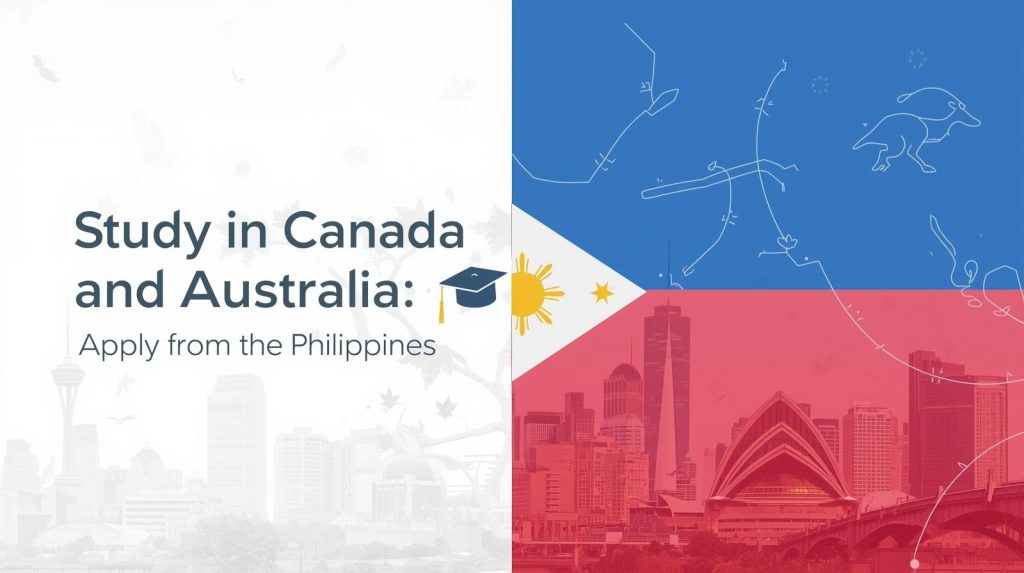Study in Canada & Australia: How to Apply From Philippines
Aspiring to study abroad in Canada or Australia opens doors to world-class education, multicultural experiences, and global career opportunities. This guide walks Filipino students through every step—from choosing programs to securing visas—so you can confidently plan your journey abroad.

Why Study in Canada or Australia?
Both Canada and Australia rank among the top destinations for international students due to their high academic standards, diverse campuses, and welcoming environments.
- Quality of Education: Degrees are recognized worldwide and often include hands-on training or co-op placements.
- Post-Study Work Opportunities: Both countries offer post-graduation work permits, enabling you to gain international work experience.
- Multicultural Societies: You’ll join vibrant communities where Filipino culture is celebrated and supported.
Choosing the Right Program and Institution
- Research Degree Programs
Identify courses that match your interests and career goals. Look for universities offering majors, minors, internships, or research in your field. - Compare Tuition and Living Costs
Estimate expenses:- Canada: Tuition ranges CAD 15,000–30,000 per year; living costs CAD 12,000–18,000 per year.
- Australia: Tuition AUD 20,000–40,000 per year; living costs AUD 20,000–25,000 per year.
- Check Entry Requirements
Most bachelor’s degrees require completion of senior high school with strong grades. Master’s programs demand a relevant bachelor’s degree and minimum GPA. - Language Proficiency Tests
- IELTS Academic: Minimum overall score of 6.0–6.5 for Canada; 6.5–7.0 for Australia.
- TOEFL iBT: Scores of 80–90 for Canada; 85–95 for Australia.
- Some institutions accept PTE Academic or CAEL.
Financing Your Studies
- Scholarships and Grants
- Canada: Look into the Vanier Canada Graduate Scholarships, Ontario Trillium Scholarships, and university-specific awards.
- Australia: Consider the Australia Awards, Destination Australia Scholarships, and institution-based bursaries.
Application deadlines vary, often six to nine months before term start.
- Part-Time Work
Student visas allow up to 20 hours of work per week during term and full-time during breaks. Factor this into your budget plan. - Education Loans
Some Philippine banks and government programs (e.g., SSS, Pag-IBIG) offer study-abroad loan packages. Compare interest rates and repayment terms.
Application Process Overview
1. Gather Academic Documents
– Transcript of Records or Diploma
– Senior high school report card (for undergraduate)
– Bachelor’s degree transcript and diploma (for graduate)
– Curriculum vitae or résumé (for graduate programs)
– Statement of Purpose outlining your goals and fit for the program
– Letters of Recommendation (academic or professional)
2. Take Language Tests
Register early for IELTS or TOEFL to ensure scores arrive before application deadlines.
3. Apply to Universities
– Complete each institution’s online application form.
– Pay application fees (USD 75–150).
– Upload academic documents, test scores, statement of purpose, résumé, and recommendations.
– Track application status through each university’s portal.
4. Receive and Compare Offers
Once you receive Letters of Offer, compare scholarship packages, tuition fees, and living-cost estimates. Confirm your acceptance by the deadline—usually within four to six weeks.
Student Visa Application
Canada (Study Permit)
- Letter of Acceptance from a Designated Learning Institution (DLI).
- Proof of Funds: Bank statements or scholarship letters showing CAD 20,635 for a single student per year.
- Identity Documents: Valid passport and recent photo.
- Letter of Explanation: Why you want to study in Canada and understand your responsibilities.
- Biometrics Appointment at the visa application center.
- Medical Exam (if required).
Processing takes around 8–12 weeks.
Australia (Student Visa Subclass 500)
- Confirmation of Enrolment (CoE) from an Australian university.
- Genuine Temporary Entrant (GTE) Statement explaining your ties to the Philippines.
- Proof of Funds: AUD 21,041 per year (e.g., bank statements, loan letters).
- Health Insurance: Overseas Student Health Cover (OSHC) for the visa duration.
- Health Check and Character Requirements: Medical exams and police clearance.
Processing takes around 4–6 weeks.
Preparing for Departure
- Housing: Apply for on-campus residences or rentals near campus early.
- Pre-Departure Orientations: Offered by Philippine scholarship agencies and universities.
- Travel Arrangements: Book flights at least two months in advance for best rates.
- Packing Essentials: Climate-appropriate clothing, prescribed medications, important documents.
Settling In and Support Services
Upon arrival, utilize university resources:
- International Student Office for orientation, legal guidance, and social events.
- Academic Advising for course selection and degree planning.
- Financial Aid Office for scholarships or emergency loans.
- Filipino Student Associations provide community connections, cultural events, and peer support.
Tips for Success
- Start your research at least 12 months before your intended start date.
- Maintain excellent grades and extracurricular activities to strengthen graduate-level applications.
- Keep copies of all documents and track deadlines on a calendar.
- Engage with alumni groups on social media to get firsthand advice.
- Learn about health care systems, local laws, and cultural norms before departure.
Embarking on a journey to study in Canada or Australia requires planning, persistence, and timely action. By following this guide, Filipino students can navigate the process effectively—turning international education dreams into reality.





